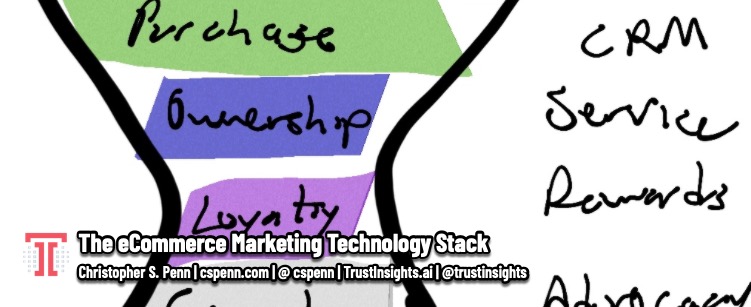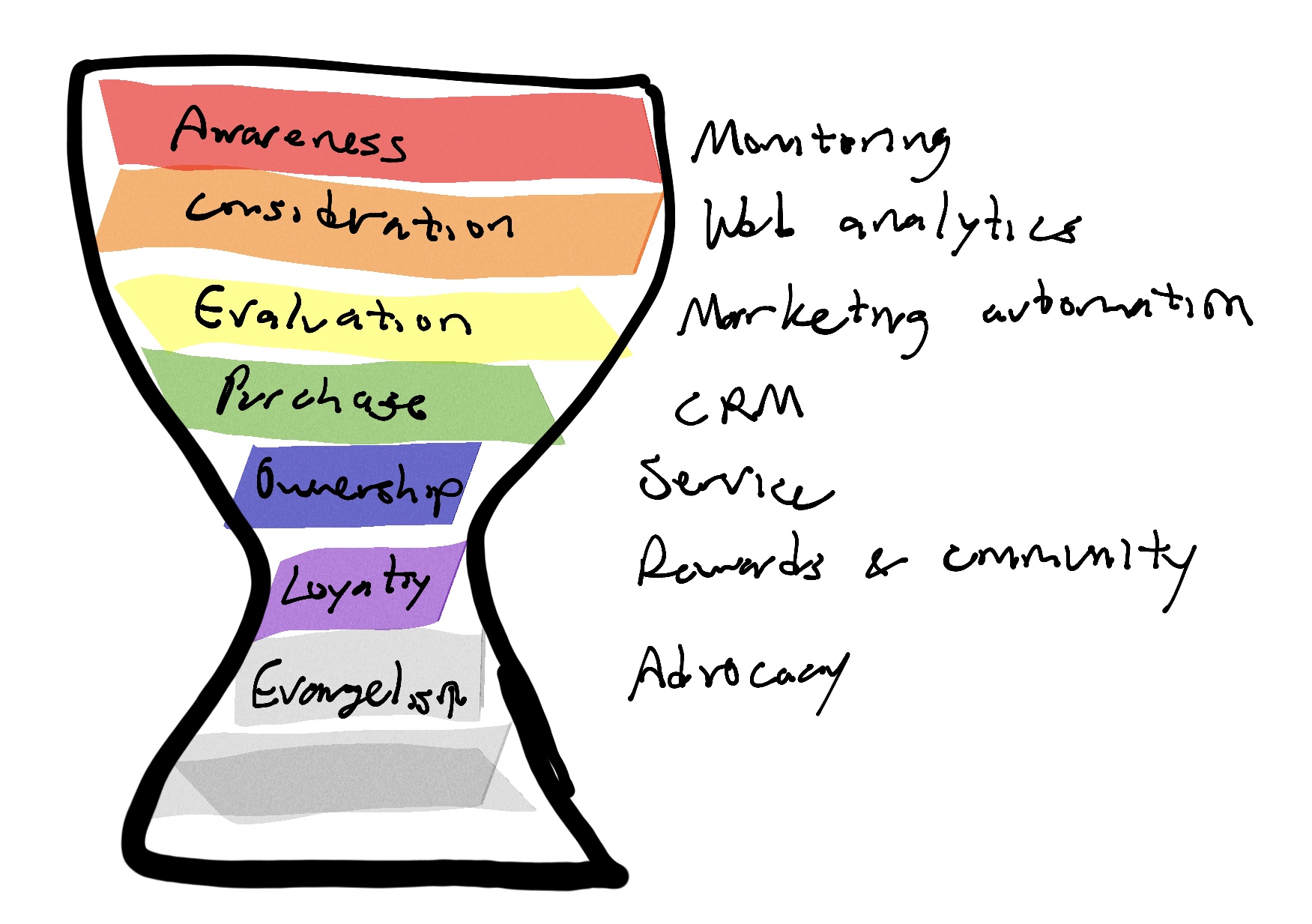
Jenna asks, “What’s a “must have” for new eCommerce brands who are just getting started with both organic and paid social media posts?”
The absolute required must-have for eCommerce brands (and any brands, really) is decent analytical infrastructure. Before you do anything, you should be prepared to measure the effectiveness of what you do. Especially for eCommerce brands, this means a robust marketing technology stack that helps you measure and manage everything relevant along the way.
What does that eCommerce marketing technology stack look like? We have to map the customer journey to our technologies:

What do we mean by these stages?
- Awareness: the customer becomes aware of their problem
- Consideration: the customer researches the problem and develops a general solution
- Evaluation: the customer identifies specific providers for their solution
- Purchase: the customer makes a purchase of their solution
- Ownership: the customer uses/consumes their solution
- Loyalty: the customer enjoys the solution and derives more value from it, or if consumable, purchases more
- Evangelism: the customer shares their solution with others having a similar problem
Now, let’s map each stage to the appropriate marketing technology.
- Awareness: monitoring solutions like social media. An example of awareness software would be a media monitoring solution like Talkwalker.
- Consideration: monitoring how the customer is doing their research. An example of consideration software would be Google Analytics, seeing what content a customer is examining.
- Evaluation: monitoring how the customer is engaging with us. Marketing automation software helps us see customer behaviors at the individual user level, from consuming specific content to registering for our email list, etc.
- Purchase: making the purchase process as easy as possible. eCommerce software like Shopify, Volusion, BigCommerce, WooCommerce, etc. all fit the bill here, along with more traditional salesforce automation software.
- Ownership: helping the customer derive value from their purchase. Service software like CRM, chatbots, FAQ management, etc. all help customers do more with their purchase.
- Loyalty: helping the customer make repeat purchases, along with increasing the value of their purchases. True CRM (as opposed to salesforce automation alone) along with rewards programs and community management software help with this.
- Evangelism: helping the customer spread the word about their delight. Advocacy software like Influitive and Birdeye help achieve this.
Now, this seems like an awful lot of technology just to answer Jenna’s question about organic and paid social media posts, doesn’t it? It is – but it’s essential because social media is a channel, not a strategy or tactic. As a channel, you can – and should – use it at any point in the customer journey; thus, if you’re using social media, you should be set up to track its impact at any given point in the customer journey, and you need the technology for that.
For example, suppose you’re using social media for problem awareness. How will you measure whether you’re even on the right track? The aforementioned awareness tools do that. But suppose you’re also handling customer support on social media. Monitoring tools will do a good job of uncovering problems, but you need a customer service-oriented solution to delegate and respond to them.
Now, suppose your customers are really happy with their purchases. How will you measure their word of mouth actions and encourage them? Your Shopify cart solution, wonderful as it is, isn’t going to do that well.
The good news is, if you set up your eCommerce MarTech stack well, you’ll not only be able to understand the value of organic and paid social media posts, you’ll also be equipped to measure and manage the rest of your marketing and customer experience as well. Social media doesn’t exist in a vacuum independent of the rest of the customer experience, nor should it have independent, siloed marketing technology. It’s a fully-integrated part of how the customer interacts with us – and thus our must-haves, our technology – must also be fully-integrated and comprehensive.
The critical mistake too many companies make is assuming social media only fits in one part of the customer journey, and pigeon-holing it into that part. Done well, with proper investment and resources, social media is an integral part of not only acquiring customers, but making them deliriously happy with you. Make the commitment and the investment up front in a comprehensive, integrated marketing technology stack, and you’ll make the most of not only your social media investments, but everything you do to make the customer happy.
You might also enjoy:
- Almost Timely News, February 11, 2024: How To Evaluate a Generative AI System
- Mind Readings: Most Analytics Data is Wasted
- Almost Timely News, February 4, 2024: What AI Has Made Scarce
- Almost Timely News, January 14, 2024: The Future of Generative AI is Open
- Mind Readings: You Need Passwords for Life in the Age of Generative AI Fraud
Want to read more like this from Christopher Penn? Get updates here:
 Take my Generative AI for Marketers course! |


Leave a Reply